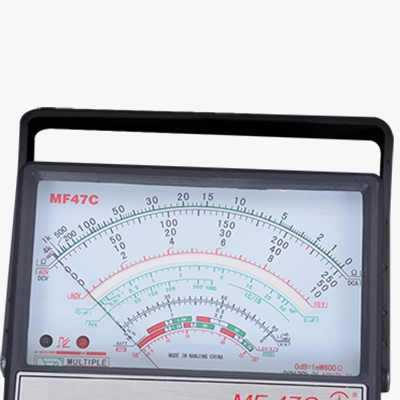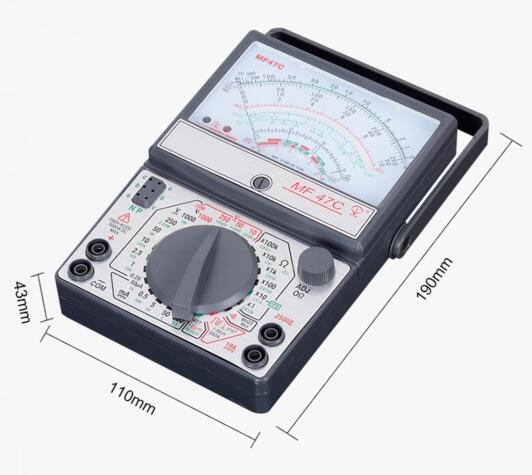Our mini analog multimeter goes beyond standard functions by incorporating a dedicated battery test feature. Invest in quality and accuracy with our mini analog multi tester and take control of your electrical measurements.

Manual Range Selection
- The mini analog multimeter features an analog multimeter with manual range selection, allowing users to choose the appropriate range for each measurement to ensure accurate readings.
- SISCO pointer multimeter includes a large screen display, making it easy to read measurements clearly and accurately.
- The straightforward design and simple operation make it easy for users to take measurements without complicated setup procedures.
- This pocket analog multimeter is capable of measuring voltage and resistance, providing versatility for various electrical testing needs.

Handheld Design with Rotatable Support Stand
- The portable analog multi meter is designed for handheld use and comes with a rotatable support stand, which can be pulled out or used to prop up the device, facilitating measurements from various angles.
- The handheld design makes it portable and convenient to carry, while the sturdy construction ensures durability for fieldwork or regular use.
- The moving needle display allows for continuous monitoring of fluctuations, providing real-time feedback on the measurements.
- The analog tester's ergonomic design ensures comfortable handling, and the support stand enhances stability during measurements, improving overall user experience.
Applications
SISCO analog multimeter is a versatile tool used in various applications, including electronics repair, electrical maintenance, car repair and laboratory testing. It measures voltage, current, and resistance, and often includes additional features such as capacitance, frequency, and temperature measurement. Its precision and multifunctionality make it essential for diagnosing and troubleshooting electrical issues in both professional and educational settings.

Car Repair

Electronics Repair

Laboratory Testing

Electrical Maintenance
| Model | SISCO-AM-MF47C | ||
| Basic Function | Range | Sensitivity | Accuracy |
| DC Current (DAC) | 0.05mA/0.5mA/5mA/50mA/500mA | 0.25V | ±2.5% |
| 10A | ±5% | ||
| DC Voltage (DCV) | 0.25V/1V/2 .5V/10V/50V | 20kΩ | ±2.5% |
| 250V/1000V | 9kΩ | ||
| 2500V | ±5% | ||
| AC Current (ACV) | 10V/50V/250V/500V/1000V/2500V | ||
| DC Resistance (Ω) | Rx1/Rx10/Rx100/Rx1k/Rx10k | Center value 16.5 | ±10% |
| Special Function | |||
| Rx100k High Impedance | / | √ | |
| Channel Buzzer | R<50Ω | √ | |
| Infrared Signal | <±15°, Distance 1~30cm | √ | |
| Capacitor (C uF) | Cx1 Cx10 Cx100 Cx1k Cx10k | √ | |
| Audio Level | Rx10hFE, 0-1000 | √ | |
| Transistor (hFE) | / | √ | |
| Battery Level | / | √ | |
| LV/LI | / | √ | |
| Standard Resistance | / | √ | |
| Multiple Protection | / | √ | |
| Dimension | |||
| Battery Specifications | 1X1.5V 2#,1x9V | ||
| Analog Multimeter Dimension | 165x116x46mm | ||
| Color Box Dimension | 375x210x54mm | ||
| Net Weight | 800g | ||
Dimension

Q1: What is an analog multimeter?
A1: An analog multimeter is a type of electrical measuring instrument that displays readings via a moving needle over a graduated scale. It is used to measure various electrical parameters such as voltage, current, and resistance in circuits, and it operates on the principle of a moving coil galvanometer.
Compared to digital multimeters, analog multimeters are valued for their ability to show continuous variations in readings, making them particularly useful for observing fluctuations in measurements. However, they are generally considered less accurate and harder to read due to the parallax error and the need for manual range selection.
Q2: How do I zero the analog multimeter for resistance measurements?
A2: To zero an analog multimeter for resistance measurements, first set the multimeter to the lowest resistance range. Touch the two probes together to create a short circuit. Adjust the zero-ohm calibration dial, usually located near the dial or on the side of the meter, until the needle points to zero on the resistance scale. This ensures accurate readings by accounting for any internal resistance in the probes and meter.
Q3: What should I do if the needle doesn't move when taking a measurement?
A3: If the needle doesn't move, check the following:
- Connections: Ensure the probes are securely connected to the multimeter and making good contact with the test points.
- Range Setting: Verify that the range setting is appropriate for the expected measurement. If the range is too high, the needle might not deflect enough to be noticeable.
- Multimeter Functionality: Test the multimeter with a known voltage or resistance to confirm it is functioning correctly. If it still doesn’t move, the meter or the probes may be faulty and need repair or replacement.
Tips: Does an analog multimeter perform better when it has a label?
An analog multimeter performs better when it has a clear and precise label because the user can easily understand the measurement ranges, scales, and functions, reducing the risk of misinterpretation and errors. Accurate labeling helps ensure that the correct settings are chosen for the specific measurement task, leading to more reliable and accurate readings.
Furthermore, a well-labeled multimeter enhances user efficiency and confidence, particularly for those who may not be as familiar with the device. Clear labels allow users to quickly and correctly set up the multimeter, facilitating smoother operation and minimizing the chances of damaging the instrument or the circuit being tested.
Thank you for buying industrial test and measurement equipment on SISCO.com, all products sold by SISCO and the partner cover a 12 months warranty, effective from the date of receiving the products.
What is covered?
SISCO is responsible for providing free spare parts, and free technical support to assist the customer to repair the defective products until the problem is solved.
What is not covered?
- Product purchased from anyone other than a SISCO store or a SISCO authorized reseller.
- Expendable parts.
- Routine cleaning or normal cosmetic and mechanical wear.
- Damage from misuse, abuse or neglect.
- Damage from use of parts other than SISCO approved.
- Damage from use outside the product’s usage or storage parameters.
- Damage from use of parts not sold by SISCO.
- Damage from modification or incorporation into other products.
- Damage from repair or replacement of warranted parts by a service provider other than a SISCO authorized service provider.
- Damage caused by the application environment not meeting the product usage requirements and the failure to perform preventive maintenance.

